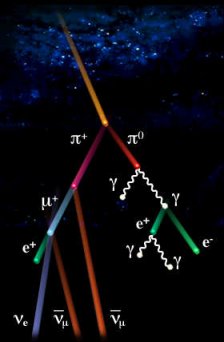 Cosmic Rays
Cosmic Rays

Cosmic rays are energetic charged subatomic particles, that bombard the Earth from anywhere beyond its atmosphere and may produce secondary particles that penetrate the Earth's atmosphere and surface. The term "ray" comes from the fact that initially, cosmic rays were thought to be some kind of electromagnetic radiation. Most primary cosmic rays (those that enter the atmosphere from deep space) are composed of familiar stable subatomic particles that normally occur on Earth, such as protons, atomic nuclei, or electrons. However, a very small fraction are stable particles of antimatter, such as positrons or antiprotons.
Cosmic rays compose a part of natural background radiation on Earth, averaging about 10-15% of it. They energies are mesured in electron volts (Ev) and their origins range from processes on the Sun, and presumably other stars as well, to as yet unknown physical mechanisms in the farthest reaches of the observable universe.
Since it's discovery by Victor Hess during a balloon ascent in 1911, balloons have played a key role on revealing the complex universe and interactions of Cosmic Rays. Nevertheless it's very hard to make a chronological evolution of the different techniques through time, because in some cases there is no sharp distinction, and also much of them althought evolved in technical complexity remain inaltered in their basic principles.
At first in early 40's, the balloon-borne cosmic ray research was dominated mainly by passive detectors. These early instruments used emulsions which had to be recovered, developed, and analyzed in the laboratory, showing the trace of the charged particles on the surface of the emulsions. With the development of electronics and balloon instrumentation, more modern instruments were developed. Cloud chambers, geiger tubes, proportional counters and so on, helped to detect new particles as pions and mesons. Also balloons incorporated telemetry systems that allowed to save electronic signals to onboard systems and/or telemetered it to the ground. This era also saw the development of several experiments using animals in specially built gondolas, trying to establish the amount of damage suffered by the test subjects exposed to this particles.
A key evolution in the field was the introduction of the balloon-borne magnet spectrometer at the end of the 60's. Before these instruments, cosmic ray experiment usually relied on particles entering and stopping within a payload. The introduction of balloons big enough to carry heavy loads, allowed to use magnetic spectrometers to analize the data from particles that penetrate all the way through a payload, allowing higher energy ranges to be reached and analyzed. Other ways of observe particles in the very high energy range are the so called transition radiation detectors and gas Cherenkov detectors, but the complexity of fly a big magnet that needs to operate at very low temperatures still poses a challenge even for today technology.
On recent years, the introduction of space-based comic rays instruments with good energy, charge, and mass resolution made similar balloon-borne payloads near obsolete. However, as ocurred before in history, ballooning adapted to this situation in two different ways. First, in order to compete and make measurements in areas not covered by space-based instruments, balloon-borne instruments extend their scope to higher energy ranges taking advantage of the fact that payloads can be much bigger and much heavier than space-based instruments, which greatly extends the energy ranges beyond what is easily available in most space-based instruments.
Second factor is the possibility to perform long-duration flights. Very high energy galactic cosmic rays are much less abundant than lower energy galactic cosmic rays, so in order to measure statistically significant amounts of these higher energy cosmic rays, are needed balloon instruments not only larger than space-based instruments -thicker for higher energies, wider for greater exposure areas- but also longer-duration balloon flights. A measurement of only one or two particles of a given energy, charge and mass, during a balloon flight of 18 hours at float altitude might be interesting, but to fly the same payload for 20 days or more, will give a lot more of those same particles, resulting in measurements with much smaller error ratio and a more interesting scientific outcome.

